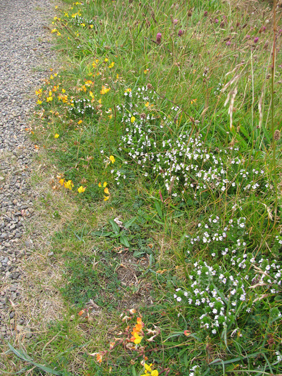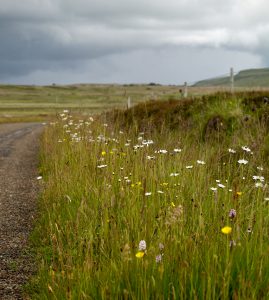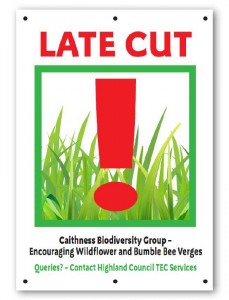
Road Verge Project
The Biodiversity Group piloted a scheme to modify the cutting of roadside verges to encourage the growth and seeding of wildflowers. Throughout Caithness, several short sections of verge totalling approximately 2000 metres were selected to have no cutting or a late cut. The expected outcome was to enhance wildflower diversity and to increase the amount of pollen and nectar available to our insect life in particular to bees.
Bumble bee populations have been dropping drastically, all 24 species of bumble bees in the United Kingdom are in decline and 2 species on the verge of national extinction. Bumble bees are much loved by many of us especially those who garden but their importance goes beyond that. They are of enormous importance as pollinators commercially for the agricultural crops on which we depend as well as for our wild and garden plants. Indeed some plants can only be pollinated by the long tongue of the bumble bee.
The Pollen and Nectar rich project has shown that small patches of land are very beneficial for bumblebee success. Many flowering plants, such as clovers, vetches as well as knapweed and marsh woundwort vital for bee survival, grow in our verges. The verges provide wildlife corridors and natural ecosystems throughout areas of intensively farmed land and built up areas thereby providing links between more flower rich land. A mid-summer cut deprives the bees of vital food and prevents these plants from setting seed.
With the aim of preserving and enhancing some of these verges especially in the areas where the Great Yellow has been found (often around our coast) or where there is an especially rich variety of flowering plants such as orchid, eyebright , vetches and yarrow the Caithness Biodiversity Group ran a trial of 14 verges in the county applying a later cut of grass which will allow the flower seeds to set for the following year . These verges were monitored and adjustments made if there are issues of safety arising.
Safety for road users takes priority and we have been working with the support of the Highland Council Community Services, who are responsible for the verge cutting for road safety purposes. Also the Road Verge Project helps the Highland Council who have a duty to preserve wildlife species and the biodiversity of the county meet their environmental obligations.
The public are encouraged to support this initiative by suggesting additional locations for inclusion in the trial next year, or alternative locations if they consider any of the current sites unsuitable by email to communityservices.caithness@highland.gov.uk.
Most of the verges benefited from the changed regime. Here is an image of Broubster verge in 2015. 
Visit the Bumblebee Conservation Trust website.
